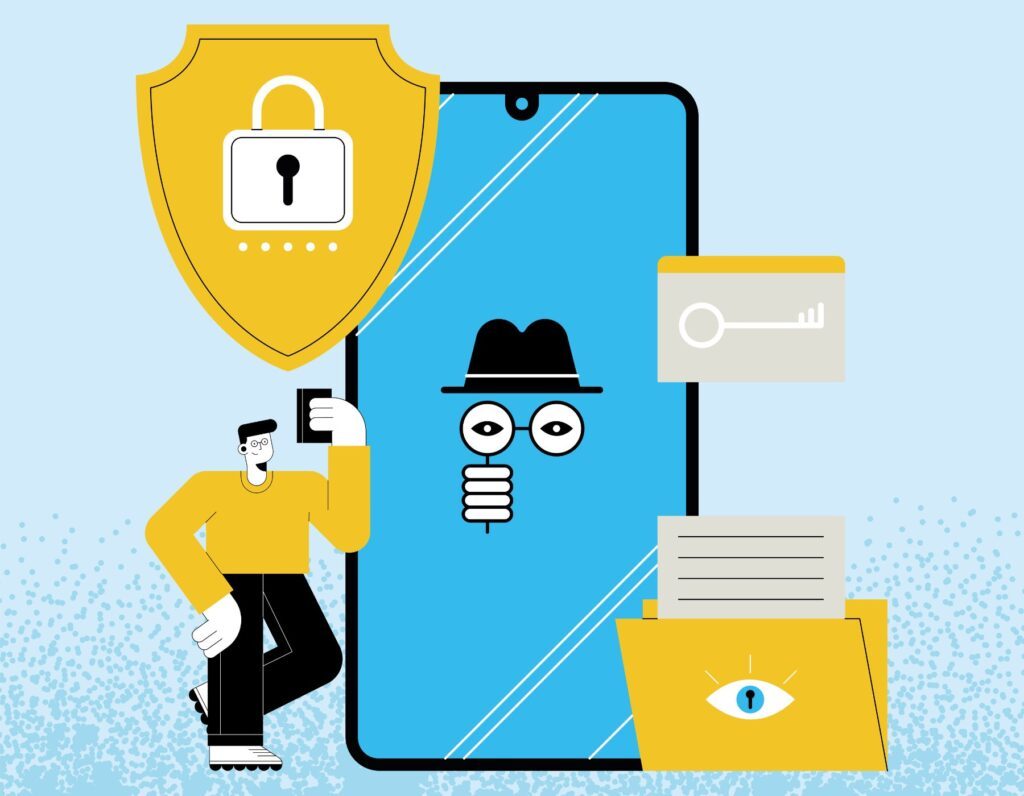- Introduction
- Cybersecurity basics for children
- Common online threats and how to stay safe
- A Safe Introduction to Mobile Phones for Children
- Teaching cybersecurity at home and in the classroom
- Conclusion

Let’s face it, technology is everywhere. Children nowadays are growing up surrounded by screens and the internet. While this has its benefits, it also exposes them to a range of cybersecurity threats. Technology is here to stay, so it’s important that we focus on teaching good cybersecurity practices to children.
The reasons for doing this are clear. Cyber threats are becoming more common and sophisticated, and children are especially vulnerable. Without the right guidance, they are at risk of experiencing cyberbullying, identity theft, scams, viruses, and more. Such an experience can be devastating and could negatively impact a child’s confidence, safety, and even future opportunities.
Teaching children about cybersecurity might feel like a daunting task, but it doesn’t have to be. Here are a few things to keep in mind when approaching this topic. Firstly, make sure the language you use is appropriate for their age. Secondly, emphasize the positive aspects of staying safe online rather than just scaring them with the negatives. Finally, allow them to ask questions and be patient when explaining concepts.
By teaching cybersecurity to children, you are empowering them with the skills and knowledge they need to stay safe in an increasingly digital world. Not only that, but it can also be a fun and engaging way to get them to think about technology and its uses. With the right approach, you can help instill good cybersecurity habits that will benefit them for years to come.
Cybersecurity basics for children

As technology continues to advance, it is becoming increasingly important to teach our children good cybersecurity practices. Cybersecurity involves protecting our devices, networks, and sensitive information from unauthorised access and damage. Here are some important concepts to consider when teaching cybersecurity basics to children.
Security starts with a strong password. A password is a secret code used to access personal accounts or devices. A strong password is one that is not easy to guess and contains a mixture of letters, numbers, symbols, and upper and lower case characters. Encourage children to use a different password for each account to prevent hackers from accessing multiple accounts.
Personal information is valuable and must be protected. Children should understand the importance of not sharing personal details like their full name, address, or phone number online. Explain that this information can be used by hackers to steal their identity and access sensitive information, such as bank accounts or medical records.
The internet is not always a safe place. Cybercriminals may use tactics like phishing or social engineering to gain access to sensitive information. Phishing involves sending fraudulent emails that appear legitimate and ask for personal information, such as login credentials or credit card details. Social engineering involves tricking people into giving out personal information by posing as a trustworthy source, such as a family member or teacher.
Teach children the importance of verifying the authenticity of requests for personal information and how to do it, for example by contacting the supposed sender directly or by checking the sender’s email address. It is also important to caution children against downloading unknown files or clicking on suspicious links, as these could contain malware that could infect the device and compromise their personal information.
Privacy is important. Children need to understand that not everyone online is who they say they are and it’s important to set privacy settings on all devices and social media accounts. Explain that it’s best to keep their profiles private so that only people they know and trust can see their posts and information.
It’s essential to understand that cybersecurity is everyone’s responsibility. By teaching good cybersecurity practices to our children, we are helping to protect them from online threats. Remember, cybersecurity basics involve providing proper tools and guidelines to ensure good passwords, privacy, and overall protection of sensitive information.
Common online threats and how to stay safe

Online safety is crucial, particularly for children who might be at greater risk of cyberattacks. As a result, it’s crucial to educate them on the dangers of the internet and how to avoid them, even if that means getting yourself up to speed with terminology.
Phishing is one of the most prevalent cyber threats. In most cases, cybercriminals use emails to trick victims into revealing sensitive information. Children must learn to identify the signs of a fraudulent email. Emails from unfamiliar sources claiming that they have won a lottery or competition, or that they must provide personal information, should be avoided at all times.
Another common cyber threat is social engineering. This is where scammers use manipulation tactics to trick people into revealing sensitive information. They can pretend to be someone else, such as a friend or relative, to gain access to your personal information. Children should be instructed to reject friend requests or social media connections from people they don’t know.
Cybercriminals frequently employ Malware to infiltrate computer systems. It’s critical to teach children how to spot and avoid downloading malware by instructing them not to download untrustworthy software or attachments from unknown sources.
Online predators can also be dangerous for kids who use social media. They might pose as someone else or pretend to be their age to extract vital information. They can entice kids to meet them in person after gaining their trust. As a result, children must be taught to avoid disclosing personal information online and to always avoid meeting new online friends in person.
Identity theft is perhaps the most severe threat to online security. Cyber criminals can obtain sensitive information, such as bank account numbers, which they may use for fraudulent purposes. It is critical to educate children about the dangers of identity theft and to teach them how to protect their personal information, such as their passwords and national insurance numbers.
By following these precautions, children can stay safe online and avoid cyber threats.
A Safe Introduction to Mobile Phones for Children

In today’s digital age, our children’s safety online is of utmost importance. ParentShield, a groundbreaking mobile telephone service, is designed to protect children and vulnerable people from the risks associated with having their own phone.
Get an overview of all calls and texts made in the online portal. The SIM works across all 4 UK networks, resulting in excellent coverage. Block numbers at the network-level, or block all numbers except for those you add into a ‘safe list’. ParentShield was designed from the ground-up for children, resulting in a mobile network that is unique, different and suited perfectly to introduce your child to the world of mobile phones.
Forget about unexpected bills. All SMS shortcodes, MMS, Premium Rate Numbers etc. are disabled, ensuring you stay within your budget without any ‘bill-shock’.
Teaching cybersecurity at home and in the classroom

Teaching cybersecurity to children can be challenging yet rewarding. From the classroom to the home, there are several methods to implement to ensure that children stay safe online. Through effective teaching methods, using games and apps, working with schools, and reinforcing practices at home, children can develop and maintain good cybersecurity habits.
Effective teaching methods involve breaking down cybersecurity practices into manageable chunks for children. It allows them to understand cybersecurity concepts in a simplified way. One way of achieving this is by creating a role-playing scenario for children to act out. Through this, children can learn how to handle suspicious requests, actions to take if they receive unsolicited emails, and to spot fraudulent emails. Another way is by discussing safe online behaviours with children, which could include being mindful of the information they post online, avoiding clicking on unknown links and limiting their time spent online.
Games and apps make learning cybersecurity interactive and engaging for children. There are various games and apps suitable for children of all ages that introduce cybersecurity concepts. For example, CyberSprinters, Cyberchase, Interland and Spoofy help children learn about online safety while having fun. These games teach children how to create strong passwords, how to use credit cards safely online, how to spot and avoid online scams and much more.
Working with schools and educators is another way of integrating cybersecurity education into the curriculum. Teachers can collaborate with cybersecurity experts to deliver the latest information and resources to their students. Educators can incorporate cybersecurity into existing subjects such as science, maths, and social studies. In doing so, cybersecurity becomes an integral part of their learning experience, increasing their awareness and knowledge.
Parents can also play a vital role in reinforcing good cybersecurity practices at home. Encouraging their children to use strong passwords for their devices and social media accounts, limiting screen time, and occasionally checking-in, are a few ways parents can ensure their children stay safe online. It is also essential for parents to educate themselves on cybersecurity, so they can support their children better.
Conclusion
In conclusion, teaching cybersecurity practices to children is crucial in keeping them safe online. Effective teaching methods, introducing games and apps, working with schools and educators, and reinforcing good practices at home are just a few ways to ensure that children develop and maintain good cybersecurity habits. By implementing these practices, we can help to protect future generations from online threats, making the internet a safer place for everyone.
Cybersecurity is no longer just an issue for businesses and governments to worry about. It’s everyone’s responsibility to ensure that they stay safe online. With children spending more and more time on the internet, it’s essential that we teach them good cybersecurity practices from an early age.
The risks of not doing so can be disastrous, from identity theft to cyberbullying and everything in between. It’s vital that we make sure our children are equipped to deal with these online dangers.
By teaching children about the importance of cybersecurity, we can empower them to stay safe online. We can show them how to create strong passwords, protect their personal information, and identify and avoid online threats like phishing scams and social engineering.
We must take action to ensure that children stay safe online. This means using games, apps, and other resources to make the learning process fun, working with schools and educators to integrate cybersecurity education into the curriculum, if it isn’t there already, and reinforcing good cybersecurity practices at home.
In short, the importance of teaching children about cybersecurity cannot be overstated. It’s our responsibility to ensure that they have the tools and knowledge they need to stay safe online. By taking action now, we can help them avoid the dangers and reap the benefits of the digital world.
